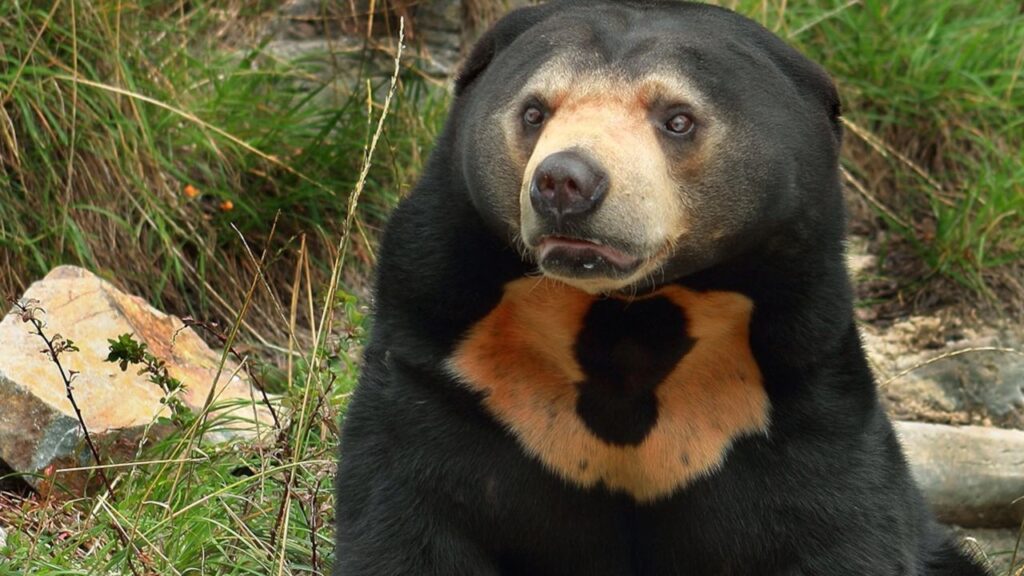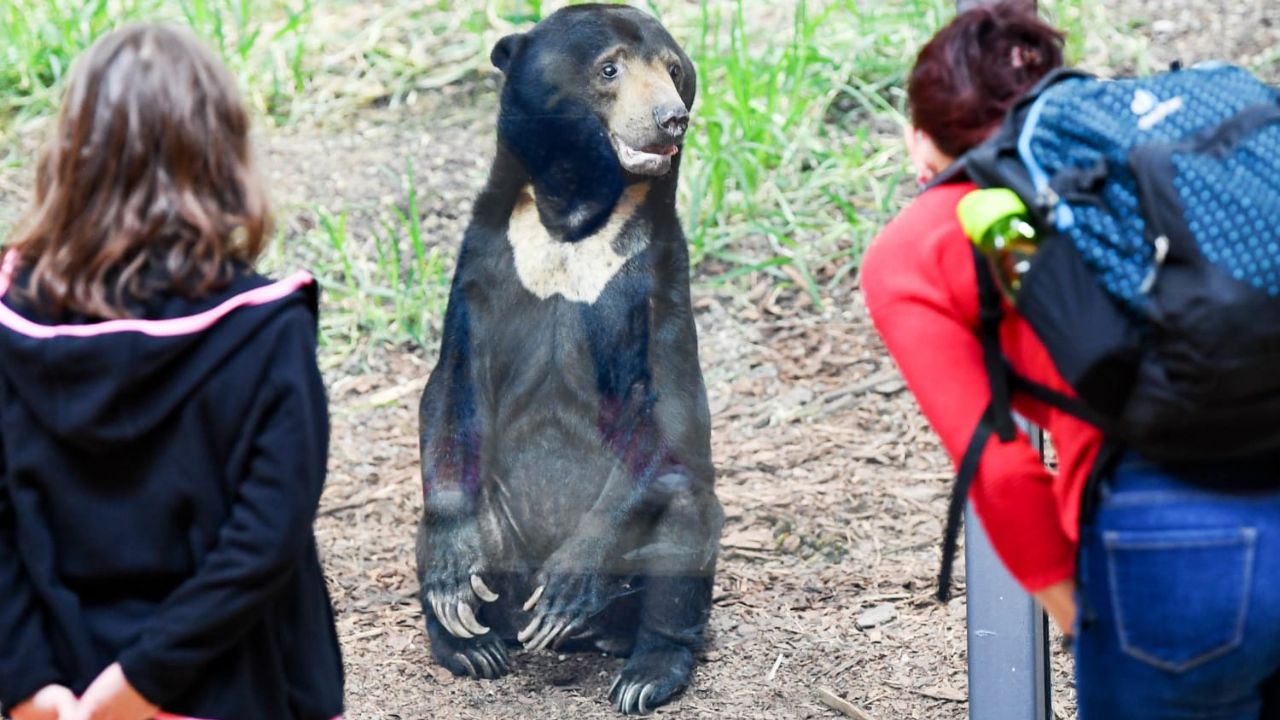Do Sun Bears Attack Humans? Sun bears are generally not aggressive but may attack humans if they feel threatened or cornered.
Sun bears, scientifically known as Helarctos malayanus, are the smallest members of the bear family and are native to the tropical rainforests of Southeast Asia.
Known for their distinctive sun-shaped patch on their chest, these bears are an essential part of their ecosystem, contributing to seed dispersion and the control of insect populations.
However, their elusive nature and occasional interactions with humans have led many to wonder: do sun bears attack humans?
In this comprehensive article, we will explore the behavior of sun bears, the circumstances that might lead to an attack, and how to avoid potentially dangerous encounters with these fascinating creatures.
Contents
What Are Sun Bears?
Overview of Sun Bears:
Sun bears, often referred to as “honey bears” due to their love for honey, are the smallest of all bear species.
They typically weigh between 60 to 150 pounds and stand about 4 to 5 feet tall when on their hind legs. [Do Sun Bears Attack Humans?]
Their short, sleek black fur and the unique yellow or white crescent-shaped patch on their chest make them easily recognizable.
These bears have a powerful build, with long, curved claws and an exceptionally long tongue used to extract honey from hives and insects from crevices.
Behavior and Diet:
Sun bears are primarily solitary animals, known to be nocturnal or crepuscular, meaning they are most active during dawn and dusk.
Their diet is diverse and omnivorous, including fruits, berries, insects, small mammals, and honey. [Do Sun Bears Attack Humans?]
They have a particular affinity for termites, ants, and honey, which they access using their strong claws and long tongues.
Unlike other bears, sun bears do not hibernate, as they live in a tropical environment where food is available year-round. Their shy and reclusive nature generally keeps them away from human activity.
Do Sun Bears Attack Humans?
General Behavior Towards Humans:
Sun bears are naturally shy and tend to avoid human contact. They are inhabitants of dense, remote forests, which naturally limits encounters with humans.
Unlike more aggressive species like the grizzly bear or polar bear, sun bears do not have a reputation for seeking out conflicts with humans.
However, they can become defensive and potentially dangerous when they feel cornered, threatened, or if their cubs are perceived to be at risk.
Reasons for Potential Attacks:
While sun bears do not typically prey on humans, there are several reasons why an attack might occur:
- Self-Defense: Sun bears, like all wild animals, will defend themselves if they feel threatened. This defensive behavior can be triggered if they are cornered or surprised.
- Protecting Cubs: A mother bear is especially protective of her cubs. If a human gets too close to her cubs, she may attack to defend them. [Do Sun Bears Attack Humans?]
- Startling Encounters: In dense forests, humans may inadvertently surprise a sun bear. Such encounters, especially if the bear feels it has no escape route, could lead to a defensive attack.
- Food Competition: In rare cases, if a sun bear perceives a human as a competitor for food, it might display aggressive behavior. This situation is more likely to occur in areas where human encroachment has led to habitat loss and reduced natural food sources for the bears.

How Dangerous Are Sun Bear Attacks?
Severity of Attacks:
Though sun bear attacks are infrequent, they can be severe due to the bear’s strong jaws and sharp claws. Injuries from sun bear attacks can range from deep lacerations and bites to more severe injuries that may require medical attention.
Unlike other larger bears, sun bears have powerful forelimbs that they use not only for climbing but also for tearing open logs and termite mounds, which could result in significant damage during an attack.
Comparative Danger Level:
Compared to other bear species such as grizzly bears, black bears, or polar bears, sun bears are generally considered less dangerous.
Grizzlies, for example, are known for their territorial aggression and powerful attacks, whereas sun bears are more likely to flee rather than confront.
However, it is important to remember that all wild animals can be unpredictable, and any bear encounter has the potential to be dangerous.
Cases of Sun Bear Attacks on Humans
Notable Incidents:
There have been recorded incidents of sun bear attacks, primarily involving farmers, villagers, or tourists who inadvertently ventured into bear territory.
For example, a few cases have been reported in Malaysia and Indonesia, where local villagers were attacked while foraging or farming near forested areas.
In these instances, the bears were either startled by the sudden human presence or were defending themselves or their cubs. [Do Sun Bears Attack Humans?]
Factors Leading to Attacks:
Several common factors often lead to these attacks:
- Encroachment on Habitat: As humans encroach further into forested areas for logging, agriculture, or development, the likelihood of human-bear encounters increases.
- Accidental Surprises: Hiking or moving quietly in dense forests can sometimes lead to close encounters that surprise a bear.
- Provocation: Occasionally, well-meaning but misguided attempts to feed or photograph the bears can provoke them into defensive behavior.

How to Avoid Sun Bear Encounters and Attacks
Safety Tips in Sun Bear Habitats:
If you are in an area known to have sun bears, it is crucial to take certain precautions:
- Travel in Groups: Bears are less likely to approach groups of people. [Do Sun Bears Attack Humans?]
- Make Noise: Making noise while walking through the forest can help alert bears to your presence, reducing the chance of startling them.
- Stay on Marked Trails: This reduces the likelihood of surprising a bear in its territory.
Preventive Measures:
- Proper Disposal of Food: Bears have an excellent sense of smell, and improper disposal of food and waste can attract them.
- Avoid Sudden Movements: If you see a bear, do not run. Running may trigger a predatory or chase response. Instead, back away slowly without making direct eye contact.
- Carry Bear Spray: In areas with frequent bear sightings, carrying bear spray can be an effective deterrent in case of an encounter.
Are Sun Bears Endangered?
Conservation Status:
Sun bears are currently listed as vulnerable by the International Union for Conservation of Nature (IUCN).
Their population is in decline due to several factors, including habitat loss from deforestation, poaching for traditional medicine, and the illegal pet trade.
Conservation efforts are critical to preserving their numbers and preventing further decline. [Do Sun Bears Attack Humans?]
Threats to Their Survival:
Sun bears face significant threats from human activities:
- Deforestation: Large-scale logging and agricultural expansion have destroyed much of their natural habitat. [Do Sun Bears Attack Humans?]
- Poaching: Sun bears are often poached for their gallbladders, paws, and other body parts, which are in high demand in some traditional medicine practices.
- Human-Wildlife Conflict: As their habitat shrinks, sun bears are forced into closer contact with humans, leading to increased conflicts.
Conservation Efforts:
Various organizations are working to protect sun bears through habitat preservation, anti-poaching laws, and raising awareness about the importance of sun bears in their ecosystems.
Supporting these organizations and advocating for stricter enforcement of wildlife protection laws can help ensure the survival of this unique species.
Final Verdict
While sun bears have the potential to attack humans, such incidents are relatively rare and usually occur under specific circumstances where the bear feels threatened or cornered. Their natural behavior is to avoid humans whenever possible.
However, respecting their space and following proper safety measures can significantly minimize the risk of a dangerous encounter.
Sun bears are vital to their ecosystems, and understanding their behavior can help promote coexistence and conservation efforts.
See Also: Do Polar Bears Attack Humans? Survival Guide!
FAQs
Are sun bears aggressive by nature?
Sun bears are generally shy and reclusive. They are not naturally aggressive but can become defensive if they feel threatened or are surprised.
What should you do if you encounter a sun bear?
If you encounter a sun bear, stay calm, avoid sudden movements, back away slowly without making direct eye contact, and do not run.
How can you identify a sun bear’s presence in the wild?
Signs of sun bear presence include claw marks on trees, tracks, broken beehives, and their distinct barking or growling sounds. [Do Sun Bears Attack Humans?]
Are sun bear attacks on humans common?
No, sun bear attacks on humans are uncommon and usually occur when the bears are surprised, feel cornered, or are defending their young.
How can you help in sun bear conservation efforts?
You can help by supporting wildlife conservation organizations, spreading awareness about sun bear protection, and avoiding products made from bears.
Conclusion: Do Sun Bears Attack Humans?
Sun bears, with their unique characteristics and shy demeanor, are an integral part of the Southeast Asian rainforest ecosystems.
While they pose little threat to humans under normal circumstances, understanding and respecting their natural behavior is crucial for fostering peaceful coexistence.
Awareness and conservation efforts are essential to ensuring the survival of sun bears and preserving the rich biodiversity of their habitats. [Do Sun Bears Attack Humans?]
By learning more about these fascinating creatures and advocating for their protection, we can help maintain a balanced and healthy ecosystem for future generations.

Hello, I am Rosa Ellis, a mother of two and a wildlife blogger. I grew up in New York City, but I love exploring forests. I’ve traveled to places like Yellowstone National Park and the Amazon Rainforest to see animals up close. I know a lot about animal behavior and which animals can be dangerous to humans. Thanks for visiting my blog!

